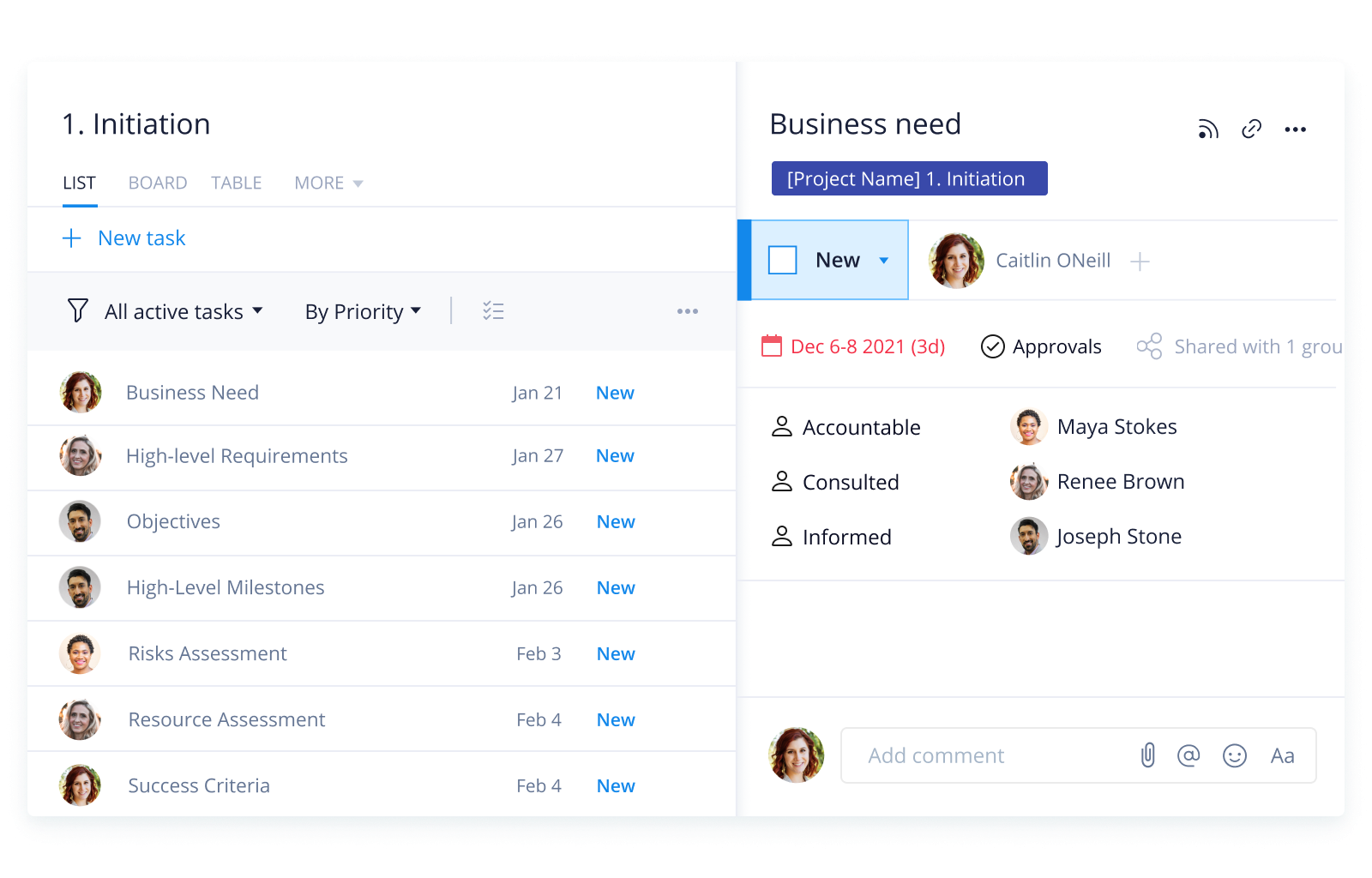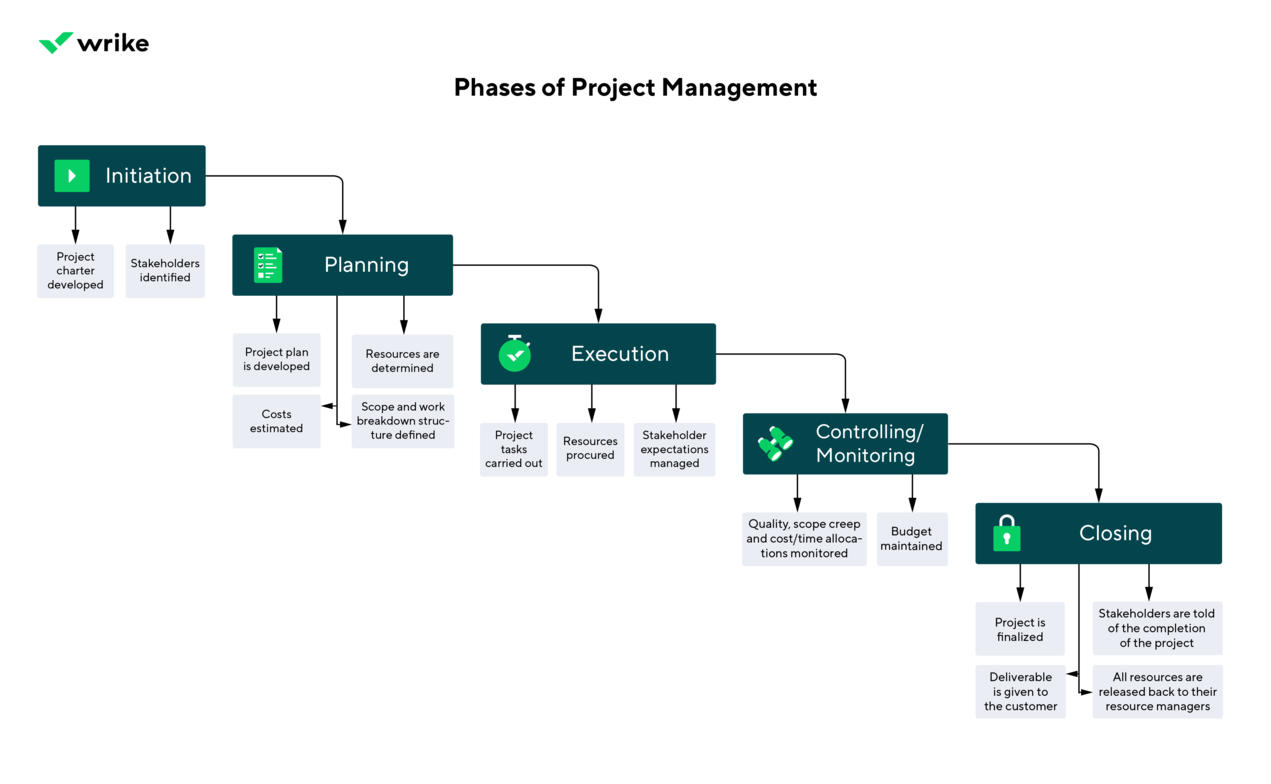What Are the Phases of Project Management?
Most projects can be divided into five key stages: initiation, planning, execution, monitoring, and closing. Project management is often carried out in these phases to improve control and quality.
These stages have similar tasks, each with a specific deliverable, and are done in a specific sequence. At the end of each phase, a review is typically conducted on the deliverable and the performance of the project team. This helps the team ascertain whether the project proceeds to the next phase or undergoes revision. It also determines how to improve the performance of all involved.
Altogether, the phases of a project are known as the project lifecycle, as outlined in the industry-standard guide, Project Management Body of Knowledge (PMBOK).

The 5 phases of project management
The five phases in a project lifecycle correspond to the project management process groups in the PMBOK. Let’s take a look at them in more detail:
Stage 1: Initiation
This phase of project management marks the beginning of the project and is where the project charter is developed, and stakeholders are identified.
How do you begin the project initiation phase? Start by developing a project initiation document, which is a blueprint of what needs to be done.
In the initiation phase, defining how you’ll measure the project’s success is also important.
- What are the key performance indicators (KPIs)?
- How will you know if you’re on track?
Setting these metrics early on will help you keep the project moving in the right direction and make adjustments as needed.
In this phase, you’ll also gather your team and project stakeholders, who will have a say in how things go.

Stage 2: Planning
This is where you create a detailed project plan. In the planning phase:
- Costs are estimated
- Resources are determined
- Requirements (scope and work breakdown structure) are defined
This is also where risk is identified and planned for, and where communications are built. The plan covers everything from project scope to resource allocation.
You can think of it as mapping out a road trip. You need to know your destination (project goals), the route (project schedule), and what you’ll need along the way (resources).
Risk management plays a huge role in this phase. What if you hit traffic? What if the car breaks down? Similarly, you’ll identify potential project risks and determine strategies to mitigate them so you can keep the project on track.
Stage 3: Execution
This project phase is where the project is carried out, all while procuring resources and managing stakeholder expectations. That’s where tools like project management software shine, helping you track progress, manage changes, and align the team.
But let’s not forget the importance of the human element in a project execution phase. The project manager works closely with the team, providing leadership and support.
This is also when you might see changes in the project scope or objectives, and you’ll need to adjust the project plan accordingly.
As illustrated in the image below, the project manager coordinates various tasks for building a new website, such as creating a wireframe, developing content, and testing, ensuring each step aligns with the overall project timeline and objectives.
Stage 4: Monitoring
This phase is often carried out simultaneously with execution because this is where quality, scope creep, and cost/time allocations are monitored.
The project monitoring and controlling stage involves regular reviews and audits.
- Are we meeting our project objectives?
- How are the resources holding up?
- Is the timeline still feasible?
You have to be proactive to catch issues before they become problems. In this phase, you watch over the project’s performance, ensuring it stays within the bounds of scope, quality, and budget.
Stage 5: Closing
This stage of project management is where the project is finalized, the deliverable is given to the customer, stakeholders are told of the completion of the project, and all resources are released back to their resource managers.
In this stage, you ensure every deliverable has met the requirements of the project and the expectations set forth at the beginning.
- Did we do what we said we would do?
- Is the customer happy?
These are the questions you must answer affirmatively. The project closing also involves a thorough review of the entire process.
- What went well?
- What could have been better?
- Did we follow everything in our project management plan?
This is a golden opportunity for learning and growth.
Finally, ensure all contractual and administrative closures are handled. Release resources, finalize supplier accounts, and ensure all paperwork, including the approval of the project by key stakeholders, is signed off.
Below is a diagram illustrating the five project management phases, showing how each one flows into the next.

So now you know the five phases of project management, but how does this differ from the project lifecycle?
What is a project lifecycle in project management?
The project lifecycle is the collection of phases that a project undergoes from start to finish. When you put together the five phases we’ve listed above — initiation, planning, execution, monitoring, and closing — you create a project lifecycle.
Following the five phases of a project lifecycle should enable your team to successfully complete a project, with data to help improve your project next time as well.
Implement the 5 project management phases in Wrike
Ready to put all these insights into action? The key to building a successful project lies in adapting to the needs of your project and team rather than following a set of steps.
With a project management tool like Wrike, you can streamline every phase of your project, ensuring not just completion but success that is both measurable and repeatable.
For instance, during the initiation phase, Wrike can help you create a project charter template that you can share with all stakeholders. As you move into the planning phase, you can use Wrike’s Gantt chart to set dependencies and visualize project progress.
During the execution phase, you can get real-time updates with our reporting features so you can be updated throughout the project. You can also track project performance against initial KPIs in the monitoring and controlling phase to make informed decisions.
Finally, in the closing phase, Wrike simplifies gathering all project documents for final review, ensuring that everything from project deliverables to reviews is organized and accessible.
Ready to lead your team through the five phases of project management? Start your free trial now.

Artem Gurnov
Artem is a Director of Account Development at Wrike. He previously held the role of Project Manager, overseeing a team of customer success managers (CSMs). Over the years of building teams and scaling business processes, he has successfully deployed multiple projects, from automating client outreach to setting up work prioritization tools for sales reps and CSMs.

